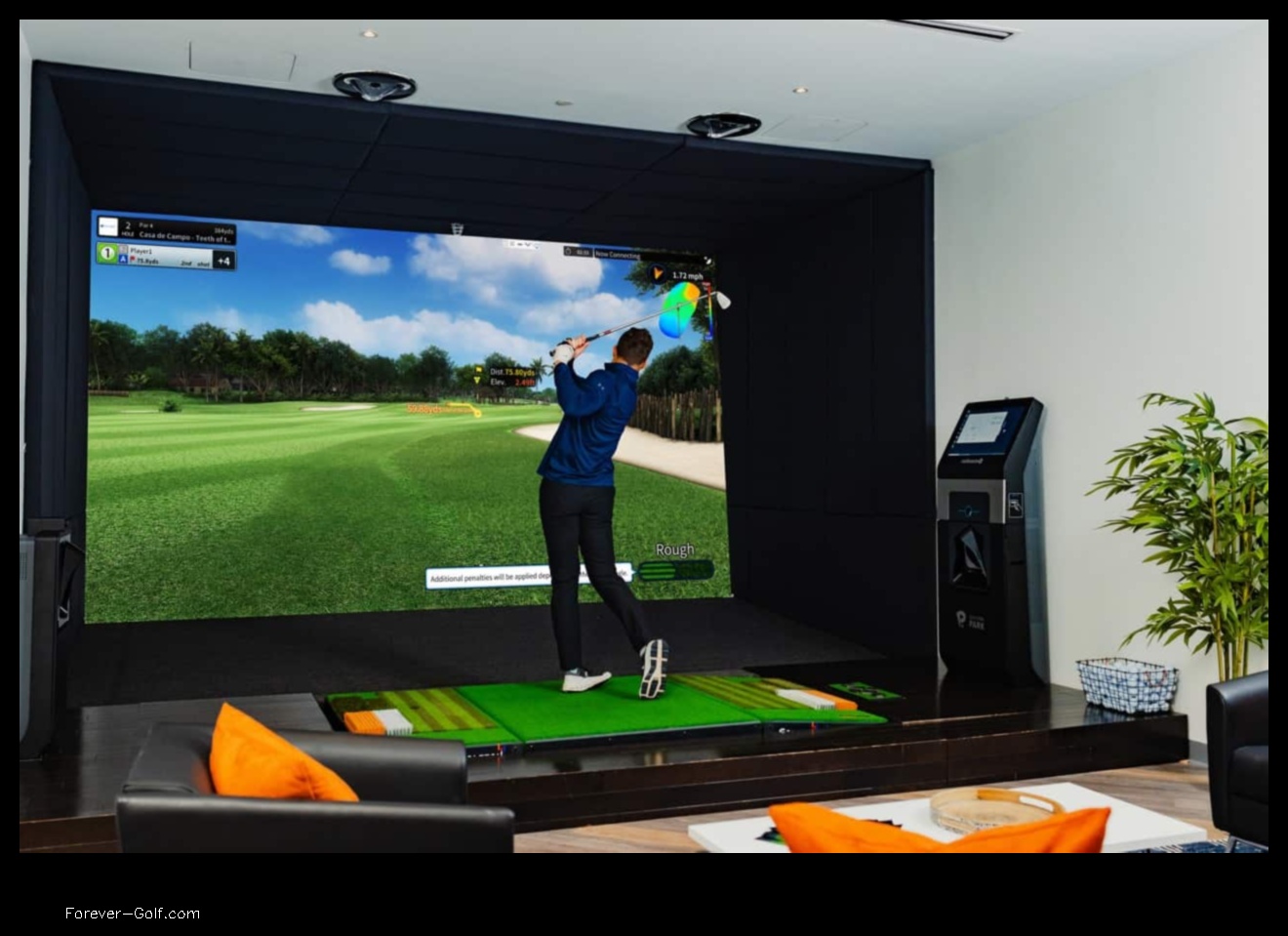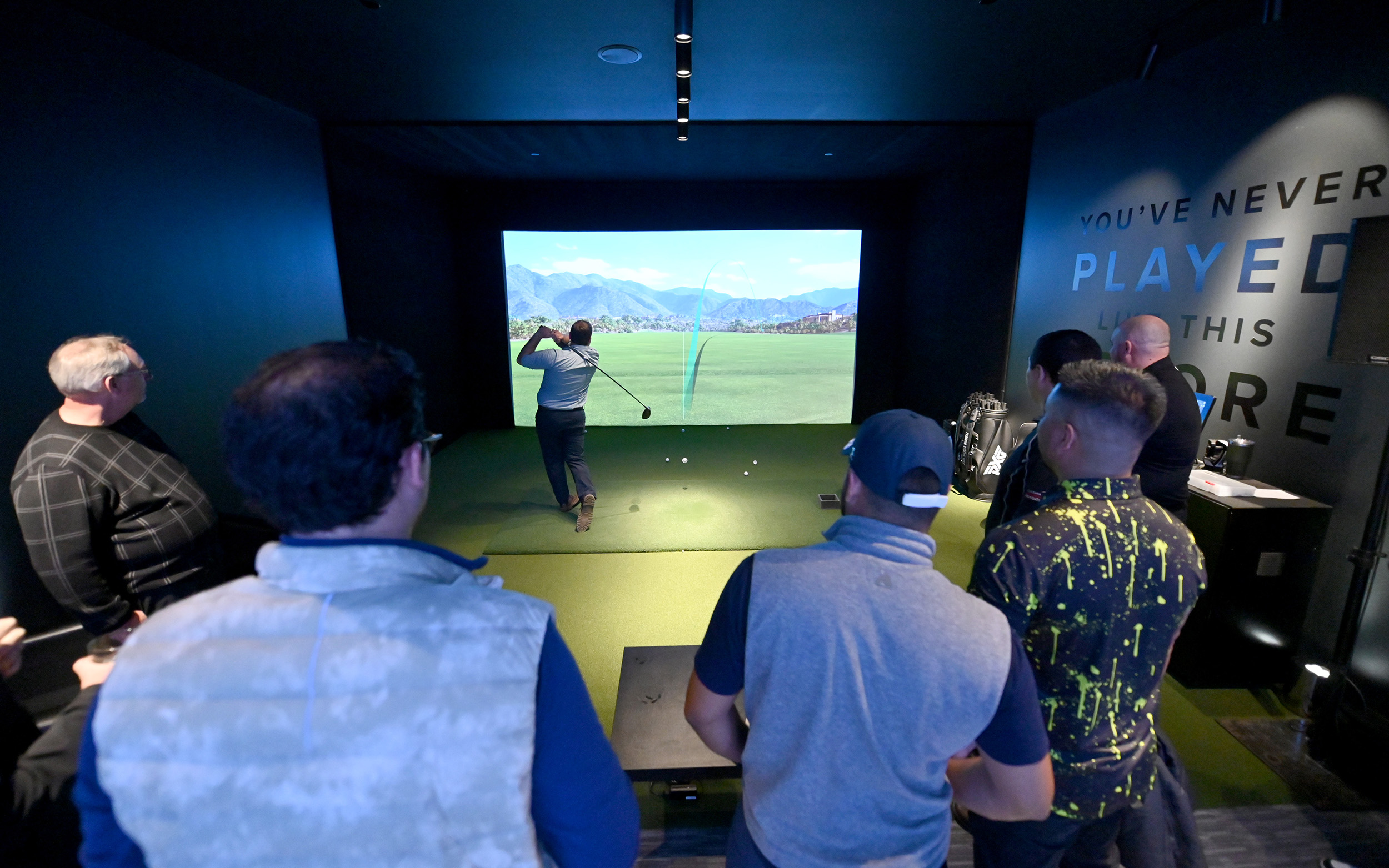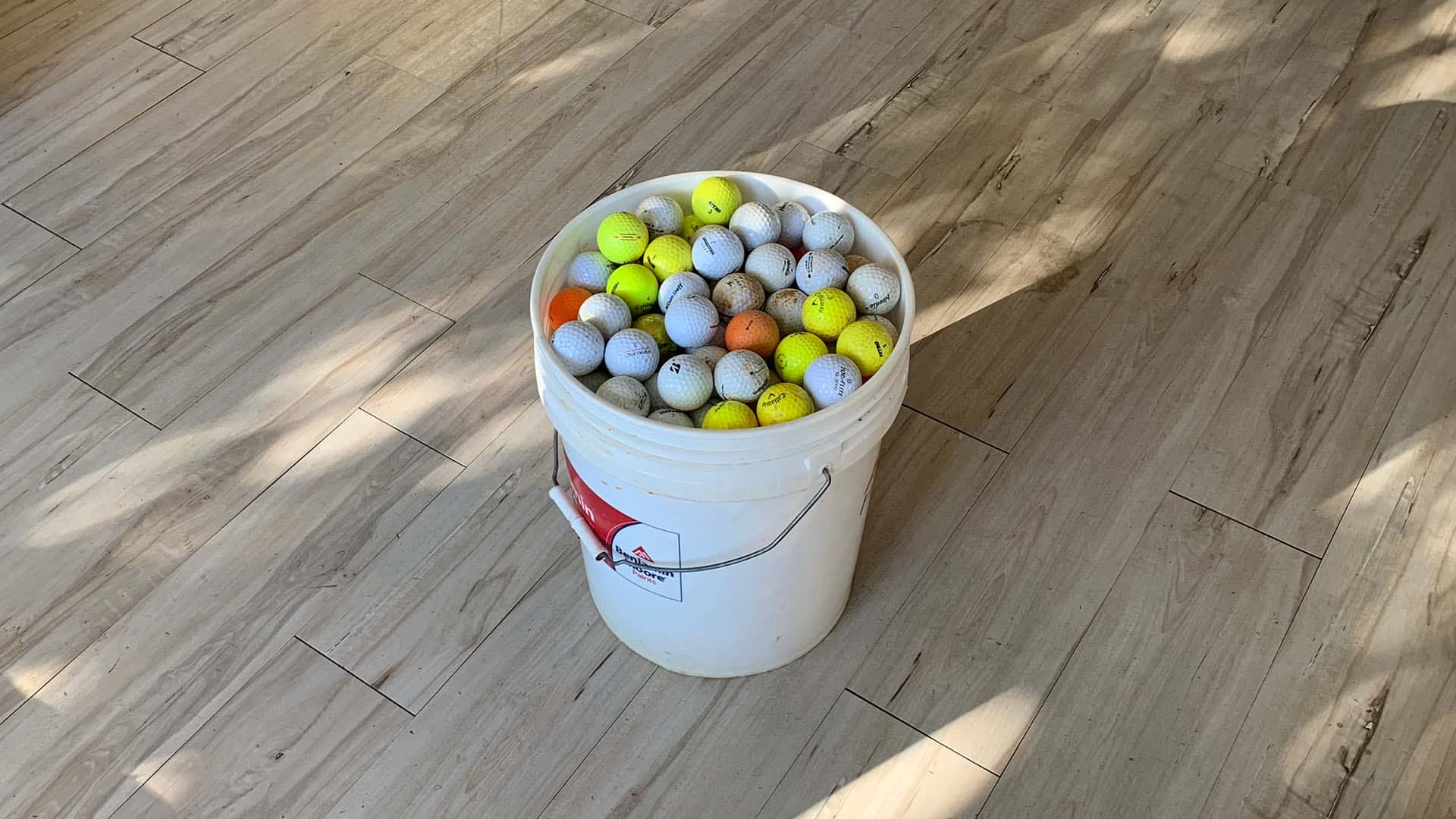
How Do Golf Simulators Work?
Golf simulators are devices that use computer graphics and projection technology to create a realistic representation of a golf course. They allow golfers to practice their swing and play virtual rounds of golf, regardless of the weather or time of day.
Golf simulators typically consist of a projector, a screen, and a hitting mat. The projector projects an image of the golf course onto the screen, and the golfer hits their ball onto the hitting mat. The simulator tracks the ball’s trajectory and calculates the distance it traveled, the launch angle, and the spin rate.
Some golf simulators also include features such as wind, weather, and hazard conditions. This allows golfers to practice in a variety of conditions and improve their overall game.
Golf simulators are a great way for golfers to improve their game and have fun. They are also a valuable tool for teaching golf to beginners.
If you are thinking about purchasing a golf simulator, there are a few things you should keep in mind. First, consider the size of the space you have available. Golf simulators can be large and bulky, so it is important to make sure you have enough room for one.
Second, think about your budget. Golf simulators can range in price from a few hundred dollars to several thousand dollars. You need to decide how much you are willing to spend on a simulator.
Finally, consider the features you want in a simulator. Some features, such as wind and weather conditions, are more important than others. Make sure you choose a simulator that has the features you want.
If you are looking for a way to improve your golf game, a golf simulator is a great option. They are a fun and effective way to practice your swing and play virtual rounds of golf.
| Topic | Answer |
|---|---|
| 1. Golf Simulators: An Overview | Golf simulators are devices that allow golfers to practice their game indoors. They typically consist of a projector, a screen, and a hitting mat. The projector projects an image of a golf course onto the screen, and the golfer hits the ball onto the mat. The simulator then tracks the ball’s trajectory and calculates the distance and direction of the shot. |
| 2. Benefits of Using a Golf Simulator | There are many benefits to using a golf simulator, including:
|
| 3. Types of Golf Simulators | There are two main types of golf simulators:
Portable golf simulators are typically less expensive than permanent golf simulators, but they are also less accurate. Permanent golf simulators are more expensive, but they offer a more realistic golfing experience. |
| 4. How to Choose the Right Golf Simulator for You | There are a few factors to consider when choosing a golf simulator, including:
Once you have considered these factors, you can narrow down your choices and find the best golf simulator for you. |

2. Benefits of Using a Golf Simulator
There are many benefits to using a golf simulator, including:
- Improve your golf swing
- Practice your game at any time of day or night
- Play different courses from around the world
- Track your progress and improve your game
- Have fun and enjoy the game of golf
If you are looking for a way to improve your golf game, a golf simulator is a great option. It can provide you with the opportunity to practice your swing, play different courses, and track your progress. Golf simulators are also a lot of fun, so you can enjoy the game of golf even when you can’t get to the course.
Types of Golf Simulators
There are a variety of different types of golf simulators available on the market, each with its own unique set of features and benefits. Some of the most popular types of golf simulators include:
* Recreational golf simulators: These are designed for casual golfers who want to improve their game and have some fun. They typically feature a projector that displays a realistic golf course on a screen, and they use sensors to track the golfer’s swing and ball flight.
* Professional golf simulators: These are designed for professional golfers who need to practice in a realistic environment. They typically feature high-end graphics and accurate ball tracking, and they can be used to simulate different courses and conditions.
* Commercial golf simulators: These are designed for use in businesses such as bars, restaurants, and hotels. They typically feature a variety of games and features that can be enjoyed by both casual and serious golfers.
The type of golf simulator that is right for you will depend on your needs and budget. If you are a casual golfer who wants to improve your game, a recreational golf simulator is a great option. If you are a professional golfer who needs to practice in a realistic environment, a professional golf simulator is a better choice. And if you are looking for a golf simulator that can be used for both casual and serious golfing, a commercial golf simulator is a good option.
4. How to Choose the Right Golf Simulator for You
There are many factors to consider when choosing a golf simulator, including your budget, the size of your space, and the features you want. Here is a brief overview of the most important factors to consider:
- Budget: Golf simulators can range in price from a few thousand dollars to tens of thousands of dollars. It is important to set a budget before you start shopping so that you can narrow down your options.
- Space: Golf simulators require a certain amount of space, so it is important to measure your available space before you start shopping. Most golf simulators require at least a 10 x 10 foot space, but some models can be larger.
- Features: Golf simulators come with a variety of features, such as different courses, weather conditions, and shot tracking. It is important to decide what features are important to you before you start shopping.
Once you have considered these factors, you can start narrowing down your options. There are many great golf simulators on the market, so you are sure to find one that meets your needs and budget.
Here are a few tips for choosing the right golf simulator:
- Read reviews: Read reviews of different golf simulators to get an idea of what other people have to say about them. This can help you identify the pros and cons of each simulator and make a more informed decision.
- Talk to a salesperson: If you are not sure what to look for in a golf simulator, talk to a salesperson at a golf store or online retailer. They can help you narrow down your options and find a simulator that is right for you.
- Try out a simulator before you buy: If possible, try out a simulator before you buy it. This will give you a chance to experience the simulator firsthand and see how it works.
By following these tips, you can choose the right golf simulator for you and enjoy hours of realistic golf practice.
5. Setting Up Your Golf Simulator
Setting up your golf simulator is a relatively simple process, but there are a few things you need to do in order to ensure that it is properly calibrated and ready to use.
First, you will need to choose a location for your golf simulator. The ideal location is one that is free from obstructions and has plenty of space for you to swing your golf club. You will also need to make sure that the area is well-lit so that you can see the projected image clearly.
Once you have chosen a location, you will need to assemble your golf simulator. This process is usually straightforward, and most golf simulators come with instructions. However, if you are having trouble assembling your golf simulator, you may want to contact the manufacturer for assistance.
After you have assembled your golf simulator, you will need to calibrate it. This process involves adjusting the projector so that the projected image is properly aligned with the hitting mat. You will also need to adjust the swing sensor so that it accurately tracks your swing.
Once your golf simulator is calibrated, you are ready to start playing!
Here are a few tips for setting up your golf simulator:
- Choose a location that is free from obstructions and has plenty of space for you to swing your golf club.
- Make sure that the area is well-lit so that you can see the projected image clearly.
- Assemble your golf simulator according to the instructions.
- Calibrate the projector so that the projected image is properly aligned with the hitting mat.
- Adjust the swing sensor so that it accurately tracks your swing.
6. Using Your Golf Simulator
Once you have set up your golf simulator, you can start using it to improve your golf game. Here are a few tips for getting started:
- Start by practicing your swing in front of the simulator. This will help you get used to the feel of the swing and the way the ball reacts to different shots.
- Once you are comfortable with your swing, start playing some simulated rounds of golf. This will help you improve your course management skills and your ability to hit different shots under pressure.
- If you are having trouble with a particular shot, use the simulator’s analysis tools to help you identify the problem. You can then work on correcting the problem in your practice sessions.
- Use the simulator to track your progress over time. This will help you see how you are improving and motivate you to keep practicing.
With a little practice, you can use your golf simulator to become a better golfer. So what are you waiting for? Start practicing today!
7. Maintaining Your Golf Simulator
Golf simulators require regular maintenance to keep them in good working order. Here are a few tips for maintaining your golf simulator:
- Clean the screen regularly with a soft cloth and a mild detergent.
- Keep the air vents in the simulator free of dust and debris.
- Replace the golf balls regularly.
- Update the software on your simulator regularly.
By following these tips, you can help to extend the life of your golf simulator and ensure that it is always providing you with the best possible experience.
Common Problems with Golf Simulators
There are a few common problems that golfers may experience with golf simulators. These problems can range from minor annoyances to major inconveniences. However, by understanding the most common problems and how to troubleshoot them, golfers can minimize the impact that these problems have on their golf game.
- Inaccurate ball flight: One of the most common problems with golf simulators is inaccurate ball flight. This can be caused by a number of factors, including the type of simulator, the lighting conditions, and the golfer’s swing. To troubleshoot this problem, golfers should try different simulators, adjust the lighting conditions, and practice their swing in a variety of conditions.
- Lack of realism: Some golfers complain that golf simulators lack realism. This can be due to a number of factors, including the lack of a real course, the lack of wind resistance, and the inability to interact with other golfers. To improve the realism of a golf simulator, golfers can try using a simulator with a high-quality graphics engine, playing on courses that are similar to the ones they play on, and using a simulator that allows them to interact with other golfers.
- Expensive: Golf simulators can be expensive, especially the high-end models. This can be a major deterrent for some golfers. However, there are a number of affordable golf simulators available on the market. Golfers should do their research to find a simulator that fits their budget and their needs.
By understanding the most common problems with golf simulators, golfers can minimize the impact that these problems have on their golf game. By doing so, golfers can enjoy the benefits of golf simulators without having to deal with the hassles.
9. Golf Simulators for Home vs. Commercial Use
Golf simulators can be used for both home and commercial purposes. There are a few key differences between the two types of simulators, which you should consider before making a purchase.
Home golf simulators are typically less expensive than commercial simulators, and they are designed to be used in a smaller space. They often have fewer features than commercial simulators, but they can still provide a realistic and enjoyable golfing experience.
Commercial golf simulators are typically more expensive than home simulators, and they are designed to be used in a larger space. They often have more features than home simulators, such as multiple bays, high-definition graphics, and advanced ball-tracking technology. Commercial simulators are often used by golf courses, driving ranges, and other businesses that offer golf lessons or tournaments.
Here is a table that summarizes the key differences between home and commercial golf simulators:
| Feature | Home Golf Simulators | Commercial Golf Simulators |
|---|---|---|
| Price | $1,000 – $5,000 | $5,000 – $100,000 |
| Space | Small | Large |
| Features | Fewer features | More features |
Ultimately, the best type of golf simulator for you depends on your needs and budget. If you are looking for a relatively inexpensive way to improve your golf game at home, a home golf simulator is a good option. If you are looking for a more realistic and immersive golfing experience, a commercial golf simulator is a better choice.
10. FAQQ: How do golf simulators work?
A: Golf simulators use a combination of sensors, software, and graphics to create a realistic golf experience. The sensors track the golfer’s swing and ball flight, and the software uses this data to render a virtual golf course. The graphics are displayed on a large screen, creating the illusion that the golfer is actually playing on the course.
Q: What are the benefits of using a golf simulator?
A: There are many benefits to using a golf simulator, including:
- Practicing at any time of day or night
- Playing different courses from around the world
- Tracking your progress and improving your game
- Having fun with friends and family
Q: What are the different types of golf simulators?
A: There are two main types of golf simulators:
- Recreational golf simulators
- Professional golf simulators
Recreational golf simulators are designed for home use and are typically less expensive than professional golf simulators. They offer a realistic golf experience, but they may not be as accurate as professional golf simulators. Professional golf simulators are used by golfers of all levels, from beginners to professionals. They are more accurate than recreational golf simulators and offer a wider range of features, such as shot analysis and course customization.
- Where Was the First Topgolf in the English Language - April 5, 2024
- Topgolf Back Net Distance How Far Is It - April 5, 2024
- Top Golf Where to Find the Best Golf Experiences Outside of the U.S. - April 5, 2024









